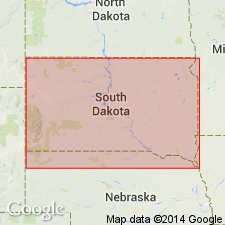
- Usage in publication:
-
- Bullhead lithofacies
- Modifications:
-
- Revised
- AAPG geologic province:
-
- Williston basin
Summary:
Modified from formal status as one of four members of the Fox Hills Formation to the informally termed Bullhead lithofacies of the newly named Iron Lightning Member of Fox Hills Formation. Name Bullhead applied to the light-gray banded badlands unit of thinly interbedded sand, silt, and clay. Most of the beds vary from a fraction of an inch to about 3 inches thick. Banding associated with degree of sorting. Flattened ovoid sand concretions with calcareous cement that weather dusky-rose are common in the sand beds. Weathered outcrop surfaces are checked, or where bentonitic, have a popcorn crust. Has abundant plant remains, and fecal pellets, gastropods, bivalves, ostracods, worm fragments, fish scales, shark and ray teeth, crocodile teeth and scutes, turtle scutes. Has local zones of contorted bedding. Intertongues with and underlies the Colgate lithofacies, also modified from formal to informal status as part of Iron Lightning Member; name Colgate applied to the white sandstones that form fluted outcrops. Overlies Timber Lake Member of Fox Hills in its north and northeast exposures, and Trail City Member of Fox Hills in its west and southwest exposures. Cross sections; nomenclature chart; measured sections; facies maps. Considered to be a delta front platform or pro-delta slope deposit of Late Cretaceous, Maastrichtian age in the Williston basin.
Source: GNU records (USGS DDS-6; Denver GNULEX).
For more information, please contact Nancy Stamm, Geologic Names Committee Secretary.
Asterisk (*) indicates published by U.S. Geological Survey authors.
"No current usage" (†) implies that a name has been abandoned or has fallen into disuse. Former usage and, if known, replacement name given in parentheses ( ).
Slash (/) indicates name conflicts with nomenclatural guidelines (CSN, 1933; ACSN, 1961, 1970; NACSN, 1983, 2005, 2021). May be explained within brackets ([ ]).

